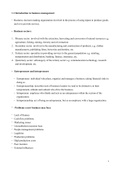Interview
Study guide for IB Business Management
This is a study guide for the IB Business Management course. It includes all chapters (including HL topics). I am an IB student and obtained excellent results studying solely by this study guide (doing practice exercises as well).
[Show more]




